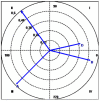Indirect Observation in Everyday Contexts: Concepts and Methodological Guidelines within a Mixed Methods Framework
- PMID: 29441028
- PMCID: PMC5797623
- DOI: 10.3389/fpsyg.2018.00013
Indirect Observation in Everyday Contexts: Concepts and Methodological Guidelines within a Mixed Methods Framework
Abstract
Indirect observation is a recent concept in systematic observation. It largely involves analyzing textual material generated either indirectly from transcriptions of audio recordings of verbal behavior in natural settings (e.g., conversation, group discussions) or directly from narratives (e.g., letters of complaint, tweets, forum posts). It may also feature seemingly unobtrusive objects that can provide relevant insights into daily routines. All these materials constitute an extremely rich source of information for studying everyday life, and they are continuously growing with the burgeoning of new technologies for data recording, dissemination, and storage. Narratives are an excellent vehicle for studying everyday life, and quantitization is proposed as a means of integrating qualitative and quantitative elements. However, this analysis requires a structured system that enables researchers to analyze varying forms and sources of information objectively. In this paper, we present a methodological framework detailing the steps and decisions required to quantitatively analyze a set of data that was originally qualitative. We provide guidelines on study dimensions, text segmentation criteria, ad hoc observation instruments, data quality controls, and coding and preparation of text for quantitative analysis. The quality control stage is essential to ensure that the code matrices generated from the qualitative data are reliable. We provide examples of how an indirect observation study can produce data for quantitative analysis and also describe the different software tools available for the various stages of the process. The proposed method is framed within a specific mixed methods approach that involves collecting qualitative data and subsequently transforming these into matrices of codes (not frequencies) for quantitative analysis to detect underlying structures and behavioral patterns. The data collection and quality control procedures fully meet the requirement of flexibility and provide new perspectives on data integration in the study of biopsychosocial aspects in everyday contexts.
Keywords: indirect observation; mixed methods; quantitizing; systematic observation; textual materials; verbal behavior.
Figures





References
-
- Allison P. D., Liker J. K. (1982). Analyzing sequential categorical data on dyadic interaction: a comment on Gottman. Psychol. Bull. 91, 393–403. 10.1037/0033-2909.91.2.393 - DOI
-
- Altimir C., Krause M., de la Parra G., Dagnino P., Tomicic A., Valdés N., et al. . (2010). Clients', therapists', and observers' agreement on the amount, temporal location, and content of psychotherapeutic change and its relation to outcome. Psychother. Res. 20, 472–487. 10.1080/10503301003705871 - DOI - PubMed
-
- Anguera M. T. (1979). Observational typology. Qual. Quant. 13, 449–484.
-
- Anguera M. T. (1990). Metodología observacional [Observational methodology], in Metodología de la Investigación en Ciencias del Comportamiento, eds Arnau J., Anguera M. T., Gómez J. (Murcia: Universidad de Murcia; ), 125–238.
-
- Anguera M. T. (1991). La metodología observacional en evaluación de programas [Observational methodology in program evaluation]. Rev. Mex. Anal. Conducta 17, 121–145.
LinkOut - more resources
Full Text Sources
Other Literature Sources

